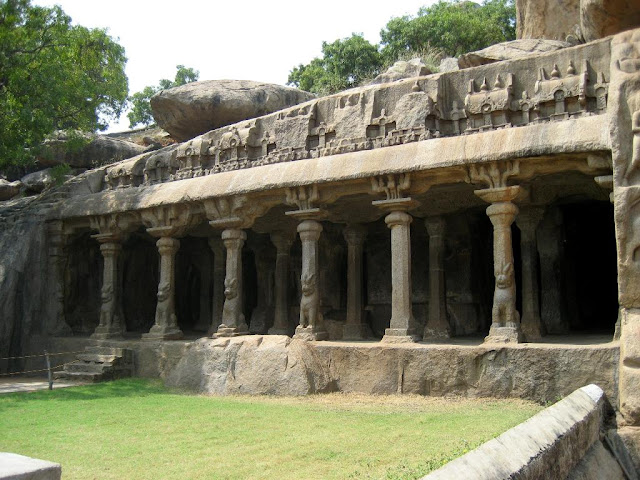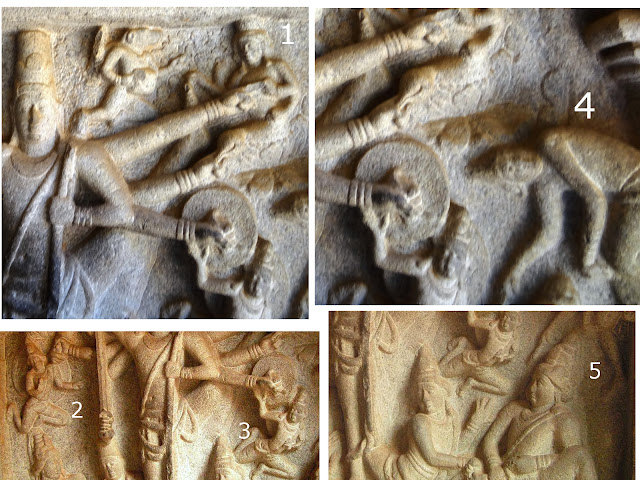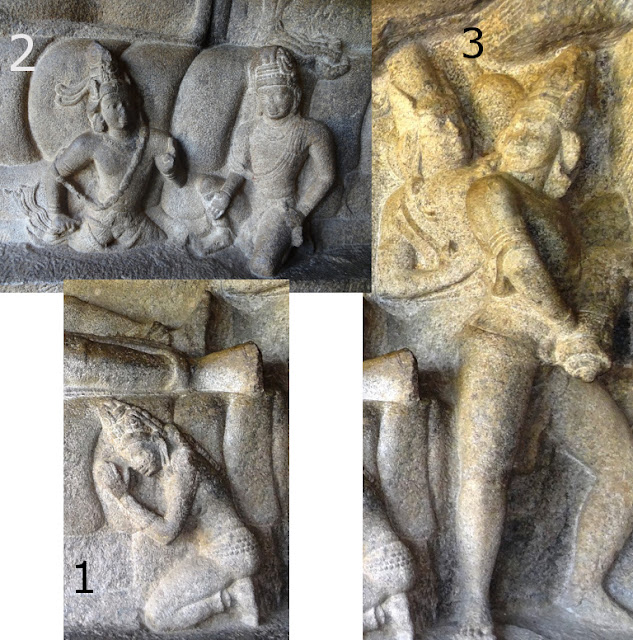It is a queer feeling when you stand somewhere knowing for
sure that many great Kings had once stood in the same place, seeing the same
things as you do, and feeling the same owe. When I went to Mahabalipuram last
year, I was mesmerized by this feeling as I walked through the magnificent sculptures
of the Pallava age. Mahabalipuram is an ancient town and seaport in the
Coromandel Coast, locate at 56km from Chennai.
Mahabalipuram is also known as Mamallapuram after the great Pallava
King Narasimhavarman Mamalla I. In some ancient scriptures, Mahabalipuram is
also referred as the “Kadal-Mallai Thalasayanam” which roughly translates to the city that lies
near the ocean and the hills.
 |
| Shore Temple of Mahabalipuram - One of the existing Pagodas out of the seven (?) |
From the days I first heard about Mahabalipuram and its
immense archaeological and historical charm, I always wanted to visit it
sometime. My wish came true in a hot, sultry May afternoon in 2014. In the
ancient times, the Europeans who passed through this Coast called Mahabalipuram
“The Land of Seven Pagodas”. Apparently Mahabalipuram was a magnificent city
with seven temples on its eastern sea shore and the myth says that the ocean
engulfed it in ancient times. However there is one temple or Pagoda still
standing in the shore of Mahabalipuram and it is known as the “Shore temple”.
During my travels, I am always curious about the stories
that hang around the destination. Mahabalipuram is a treasury of myths and folklore.
It all starts with Hiranyaksha, the Asura(Demon) who abducted the Bhumi Devi(Goddess Earth) deep
into the oceans. Vishnu took the form of a boar (Varaha) to rescue her and
killed Hiranyaksha in the fight. Hiranyakashipu was the elder brother of
Hiranyaksha and he refused to adore Vishnu. Prahalada was the son of Hiranyakashipu.
Due to the influence of Shukracharya – the sage and guru, Prahalada became a
Vishnu devotee.
Hiranyakashipu was enraged and ordered to kill Prahalada; however he couldn’t due to the divine intervention. Hiranyakashipu changed his mind after some time and invited Prahalada back into his court. However, Hiranyakashipu challenged Prahalada to prove Vishnu is omnipresent. He stroked down a huge pillar as a challenge to the omnipresent God. Vishnu emerged out of the pillar in his Narasimha Avatar and killed Hiranyakashipu and installed Prahalada in the throne. Son of Prahalada was known as Virochana and he had a son named “Bali”. “Bali”- the grandson of Prahalada - founded the magnificent city of Mahabalipuram.
Hiranyakashipu was enraged and ordered to kill Prahalada; however he couldn’t due to the divine intervention. Hiranyakashipu changed his mind after some time and invited Prahalada back into his court. However, Hiranyakashipu challenged Prahalada to prove Vishnu is omnipresent. He stroked down a huge pillar as a challenge to the omnipresent God. Vishnu emerged out of the pillar in his Narasimha Avatar and killed Hiranyakashipu and installed Prahalada in the throne. Son of Prahalada was known as Virochana and he had a son named “Bali”. “Bali”- the grandson of Prahalada - founded the magnificent city of Mahabalipuram.
There is also a folklore about an eminent prince of
Mahabalipuram, known as Mallicheren, who was in a thick friendship with a Gandharva(nymph)
from heavens and Mallicheren stealthy visited heaven once. Awed by the beauty
of the heaven, Mallicheren came back to Mahabalipuram and replicated the heavenly
splendor in the architecture of Mahabalipuram. The Lord Indra grew furious and jealous,
he appointed “Varuna” the God of ocean to engulf Mahabalipuram. The angry ocean
attacked Mahabalipuram and the city with swish palaces and elegant seven pagodas
was gone in moment.
 |
| The roof of a Mahabalipuram temple uncovered during 2004 Tsunami By Pspk [CC0], via Wikimedia Commons |
The old people in Mahabalipuram still remember their
grandparents mentioning about seeing the tip of the seven pagodas far away in
the sea with their gold plated Shikhara(tower) glittering in morning sun. This may be
just an urban legend; however during 2004 Tsunami in the Bengal Ocean,
Mahabalipuram beach pulled back around 500meters and tourists witnessed a large row of rocks emerging out of the water!
It might be the remains of the seven pagodas. As the coast line changed after Tsunami, it
unearthed few sculptures which were previously submerged in water.
The history of Mahabalipuram from 6th century AD
is very well documented. Majority of the sculptures and temples in
Mahabalipuram is attributed to the great Pallava dynasty starting with Simhavishnu. From 550AD, Pallavas created the cave temples (Mantapas),
Monolithic temples (Rathas) and structural temples (like Shore temple) in
Mahabalipuram.
There are around 8 cave temples in different parts of the
Mahabalipuram town; however it takes almost a day to visit all of these. Most
of the tourists only visit two or three as they don’t know the existence of the rest. We also did not get the chance
to visit all the caves, but I have gathered information about all of them so
that someone with keen interest doesn’t miss them. As we entered into the
Mahabalipuram town, the first land mark is a huge bas relief on the side of a
30 feet tall rock. This marvelous creation is known as the Arjuna’s Penance.
It was blazing hot and we decided to first explore the cave
temples as they provide some shelter from the heat. Standing on the Mada Koil road,
we first entered in
to a cave temple standing just opposite to the road side. It is known as the “Krishna Mandapa”.
to a cave temple standing just opposite to the road side. It is known as the “Krishna Mandapa”.
1. The Krishna Cave Temple
We walked past through the pillared portico of Krishna cave temple which dates back to 650 AD. There are two rows of pillars. The first row is very ornate with seated Vyaalis(Dragons) at the bottom and the
second row is less ornate compared to the first. As we entered the cave we saw a sculpture of Krishna lifting the Govardhana hill to protect cows and his kin from the heavy rain.
There are casual scenes also, like a cow is being milked while it is licking its calf. These scenes from the everyday life marvelously integrated into the of the mythological themes makes the sculptures of Mahabalipuram humane and divine at the same time.
The Krisha cave was initially a bas relief just like the Arjuna's penance. The pillared Mandapa in front of the Krishna cave is attributed to much later period of Vijayanagara Empire. (1409- 1542)
There is another cave temple known as the "Varaha Mandapa" located very near to the the Krishna cave temple. Our next destination was this cave temple.
We spent an ample time within the Varaha cave and as we moved towards the rocky mountain side of Mahabalipuram, we saw a stunning piece of rock.
This rock, which looks like some one has scooped it out of a hill, is known as the "Krishna's Butter Ball". It is believed that this rock was there for at least 1000 years . During the olden times, the European rulers of India tried to move this rock with the help of elephants but they couldn't! As I looked at the people relaxing under this massive rock, least bothered about the chance of the rock rolling down, I couldn't help but wonder that - "It is all about faith!"
We started walking towards the light house in distance and we saw some small caves on the way. We decided to visit them on our way back. Our destination was the most famous cave temple of Mahabalipuram - Mahishasura Mardini Mandapa
There are casual scenes also, like a cow is being milked while it is licking its calf. These scenes from the everyday life marvelously integrated into the of the mythological themes makes the sculptures of Mahabalipuram humane and divine at the same time.
The Krisha cave was initially a bas relief just like the Arjuna's penance. The pillared Mandapa in front of the Krishna cave is attributed to much later period of Vijayanagara Empire. (1409- 1542)
There is another cave temple known as the "Varaha Mandapa" located very near to the the Krishna cave temple. Our next destination was this cave temple.
As we entered into the
“Varaha Mandapa” there was a visual treat right near the entrance of
the temple. It was the panel depicting the rescue of Bhu-Devi by Vishnu
in his Varaha Avatar. The varaha panel features the four armed Vishnu lifting Bhu-devi
from the abyss. In the rear hands he carries a Shankha and Chakra.
Vishnu has placed his foot is on the serpent Shesha Naga(1). Surya is seen on the top left(2), Chandra is shown among clouds on the top right and Brahma and Narada standing behind Varaha(3) . To the left of the Seshanaga, there is a female figure it could either be Bhudevi before rescue of the consort of Seshanaga. There is a male figure behind her, which could be either Shiva.(4)
Vishnu has placed his foot is on the serpent Shesha Naga(1). Surya is seen on the top left(2), Chandra is shown among clouds on the top right and Brahma and Narada standing behind Varaha(3) . To the left of the Seshanaga, there is a female figure it could either be Bhudevi before rescue of the consort of Seshanaga. There is a male figure behind her, which could be either Shiva.(4)
On the opposite side of the wall, we found the Tri-Vikrma
Panel. This panel shows Vishnu in Vamana Avatar. This panel features the story of Vishnu in the modest Vamana Avatar demanding the Asura King Bali to grant him three foot of land to do his prayers. The generous Bali immediately agreed. Suddenly Vamana converted himself
into the huge form of Trivikrama measuring the earth and heavens by two steps. He asked Bali, for the third step that he was promised. The Trivikram panel depicts this moment. Eventually, as per the legends, Bali offers his own head to Vishnu, thus keeping his promise and sacrificing himself.
The feet of Thrivikram is pointed at the Brahma loka where Brahma is adoring the feet of Vishnu.(1) Surya and Chandra are at Vishnu’s waist level possibly indicating the huge dimension of Trivikrama (2,3). The bottom of the panel shows a bewildered Bali accompanied by Shukracharya to his left.(5)( I remembered that the mythology states that Shukracharya had initially warned Bali that Vamana's request is a trap, but Bali did not listen to him.). A curious figure at the right side must be
“thrisanku” neither in heaven or earth, or in limbo.(4)
The body of Tri-Vikrama is dividing the whole panel into three regions. till the knee of Trivikrama is Bhu-loka(Earth), above it up to naval is Antariksha-loka(Sky), and above it up to forehead is Swarga-loka(Heaven). So we can see Bali and Sukracharyar was on the knee level, the sun and moon are on the waist level and Brahma and Shiva is above forehead denoting the Swarga loka.
 |
| By Benjamín Preciado (Own work) [CC BY-SA 4.0-3.0-2.5-2.0-1.0], via Wikimedia Commons |
The body of Tri-Vikrama is dividing the whole panel into three regions. till the knee of Trivikrama is Bhu-loka(Earth), above it up to naval is Antariksha-loka(Sky), and above it up to forehead is Swarga-loka(Heaven). So we can see Bali and Sukracharyar was on the knee level, the sun and moon are on the waist level and Brahma and Shiva is above forehead denoting the Swarga loka.
We walked around to see the other panels in this temple which includes the Gajalakshmi panel
and the Durga Panel. A seated Gajalakshmi, holding lotuses in both the hands is assisted by maidens carrying water vessels. Two elephants are shown, one
pouring water over Gajalakshmi and other is taking the vessel from the maiden.
Next to this panel is a bas relief of Durga with four arms. Durga is standing with with her Vahanas (Vehicles) and Gupta Ganas(Army) and devotees. One of the devotee is offering his head(that is horrifying! ) and other showing vismaya.
Next to this panel is a bas relief of Durga with four arms. Durga is standing with with her Vahanas (Vehicles) and Gupta Ganas(Army) and devotees. One of the devotee is offering his head(that is horrifying! ) and other showing vismaya.
We spent an ample time within the Varaha cave and as we moved towards the rocky mountain side of Mahabalipuram, we saw a stunning piece of rock.
This rock, which looks like some one has scooped it out of a hill, is known as the "Krishna's Butter Ball". It is believed that this rock was there for at least 1000 years . During the olden times, the European rulers of India tried to move this rock with the help of elephants but they couldn't! As I looked at the people relaxing under this massive rock, least bothered about the chance of the rock rolling down, I couldn't help but wonder that - "It is all about faith!"
We started walking towards the light house in distance and we saw some small caves on the way. We decided to visit them on our way back. Our destination was the most famous cave temple of Mahabalipuram - Mahishasura Mardini Mandapa
 |
| The front part of Mahishasura Mardini cave showing the lion pillars |
3 Mahishasura Mardini Mandapa
Off the “Mada Koil Street” near the Mahabalipuram lighthouse, the Mahishasura Mardini cave temple is located. We had to walk past the light house to locate this cave temple. A good tour guide can route you very well. The central sanctum of this temple has Siva and Uma with toddler Skandha in between them they are seated relaxed, placing their feet on Nandi.
As I climbed the steps leading to the pillared portico (Mandapam) of the Mahishasura Mardini cave, I couldn’t control my excitement to see that one structure known as the “Masterpiece of Indian bas relief” - war between Goddess Durga and Mahishasura.
It is a dynamic scene from the battle between the elegant and slender Durga and the stout and powerful Mahishasura . The characters in this panel are perfectly positioned in time and space. Durga about to strike an arrow at Mahishasura, the Asura in a quite frightened and awed posture trying to hit one last time. It also portrays the vigorous army of Durga and the disheartened army of Mahishasura. The emotion of not only the main characters, but on every living being in this panel is perfectly captured.
I spend some time looking around the panel wishing if the world knew the genius (es) who created this master piece. Unfortunately only the Kings are always remembered and the artisans are nameless. I usually control the urge to touch and feel the archaeological pieces as it would tamper them. but I couldn't control myself here and I touched this panel for quite a long time trying to connect with that unnamed genius who created it.
I spend some time looking around the panel wishing if the world knew the genius (es) who created this master piece. Unfortunately only the Kings are always remembered and the artisans are nameless. I usually control the urge to touch and feel the archaeological pieces as it would tamper them. but I couldn't control myself here and I touched this panel for quite a long time trying to connect with that unnamed genius who created it.
Another bas-relief that is no lesser marvel than the above one is the “Vishnu Anantha Shayi in yoga nidra “ ”(The God Vishnu in meditative sleep on his five hooded serpent “Sesha Naga or Anantha”).
The figures around Vishnu are also note worthy. Bhu-devi is praying on the right side of the Vishnu (1) and Asuras Madhu and Kaidhaba are prepared to do the evil (Legend here) and standing at the right most corner of the panel(3). Ayudha purusha are at the lower level(2) (Vishnu weapons in the human form are known as Ayudha purusha). Surya and Chandra are on the either top sides of the panel.
The figures around Vishnu are also note worthy. Bhu-devi is praying on the right side of the Vishnu (1) and Asuras Madhu and Kaidhaba are prepared to do the evil (Legend here) and standing at the right most corner of the panel(3). Ayudha purusha are at the lower level(2) (Vishnu weapons in the human form are known as Ayudha purusha). Surya and Chandra are on the either top sides of the panel.
We walked back along the side of the Mahabalipuram light house. The hot sun burning above us doesn't seem to matter as we knew much more fine specimens of Indian sculpture and architecture was waiting for us in the dark hidden caves of Mahabalipuram. On the way back we stopped to visit one of the lesser decorated caves known as the Ramanuja Mandapa (To be continued...)


















Nice to see a blog post by you again.
ReplyDeleteEnjoyed it!
3B8BED0327
ReplyDeletehacker arıyorum
hacker kirala
tütün dünyası
hacker bul
hacker kirala
Post a Comment